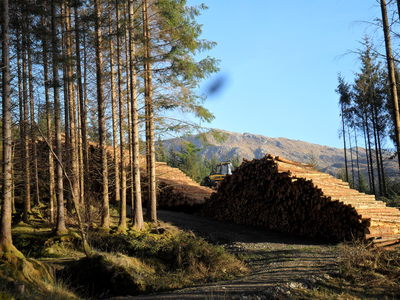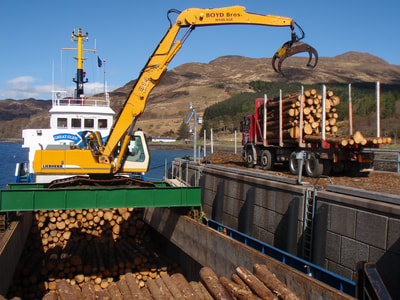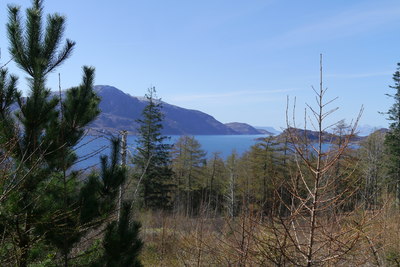LOOKING AFTER THE WOODS
RESTRUCTURING INVERIE WOODS
Inverie Woods provide the backdrop to Inverie village, covering an area of 240 hectares and enclosed by a deer fence that goes into the sea at Scottas and Kilchoan. The woods are made up of conifers planted between 1963 and 1971, areas that have been recently harvested and replanted, small pockets of ancient native woodland and naturally regenerating native trees. We are managing this valuable woodland resource to provide multiple benefits now and in the future.
Many of the conifers planted in the 60/70s are blowing down. We have a 20 year plan to harvest the unstable conifers and replant with mixtures of trees that will provide useful quality timber for the future and greater biodiversity. We have completed 3 phases of harvesting in Inverie Woods in 2007, 2015 & 2017. A total of 12,500 tonnes of timber has been harvested, most of this was exported by boat and sold to big sawmills and some was kept to meet local milling and firewood needs.
Harvested areas with better soil and access are replanted with species that will be useful for timber in the future such as oak and western red cedar. Other areas are replanted with species that have a high habitat value such as Scots pine, birch and rowan.
Harvested areas with better soil and access are replanted with species that will be useful for timber in the future such as oak and western red cedar. Other areas are replanted with species that have a high habitat value such as Scots pine, birch and rowan.
BIODIVERSITY
Trees and woodland play an important role in safeguarding biodiversity by providing a patchwork of wildlife rich habitats to form the building blocks of an ecologically sustainable landscape. We are actively managing our woods to increase biodiversity - here's how we do it:
Rhodie Eradication
Rhododedron ponticum (commonly known as rhodies) was first introduced to Knoydart by the Victorians – they are highly invasive and outcompete most other plants, suppress ground flora, spread vigourously and dominate habitats casuing the loss of variety and abundance of other plant life and other orgnaisms.
Since 1999, we have cleared 55 hecatres of dense rhodies over an area of 250 hectares on community owned land with a little help from our our friends! In 2020 to make sure that regrowth over the years did not take hold we carried out a sweep of the whole area of land to remove regrowth and new growth from dispersed seed. We are also working on a citizen science intitiative supported by the Heritage Lottery Fund to inform the community and public about the impact of rhodies and the importance of biodiversity and get involved in identifying and reporting any rhodies spotted.
Read more about our Rhodie Challenge here.
Rhodie Eradication
Rhododedron ponticum (commonly known as rhodies) was first introduced to Knoydart by the Victorians – they are highly invasive and outcompete most other plants, suppress ground flora, spread vigourously and dominate habitats casuing the loss of variety and abundance of other plant life and other orgnaisms.
Since 1999, we have cleared 55 hecatres of dense rhodies over an area of 250 hectares on community owned land with a little help from our our friends! In 2020 to make sure that regrowth over the years did not take hold we carried out a sweep of the whole area of land to remove regrowth and new growth from dispersed seed. We are also working on a citizen science intitiative supported by the Heritage Lottery Fund to inform the community and public about the impact of rhodies and the importance of biodiversity and get involved in identifying and reporting any rhodies spotted.
Read more about our Rhodie Challenge here.
Native Woodland Regeneration
The ancient native woodland from Millburn to Scottas is regenerating. We are helping this happen by planting species such as oak that are slower to regenerate (these trees are also favoured by the deer so are given extra protection with platic tubes until the are strong enough). We maintain the fence around Inverie to keep the deer out and work with the Knoydart Foundation to cull deer inside the fence to manage the impact of deer on the habitat.
Thinning
We thin the trees in the forest by ring barking to favour native woodland and create gaps to encourage natural regeneration. A ring is cut around the bark of the tree to cut off the suppply of nutrients from the roots, killling the tree but leaving it standing providing the added benefits of the deadwood ecosystems.
Deadwood Management
Where possible we leave fallen trees and branches on the woodand floor as deadwood provides habitat and food sources for lichens, fungi, bryophytes and a vast array of invertebrates, hole nesting birds and mammals.
The ancient native woodland from Millburn to Scottas is regenerating. We are helping this happen by planting species such as oak that are slower to regenerate (these trees are also favoured by the deer so are given extra protection with platic tubes until the are strong enough). We maintain the fence around Inverie to keep the deer out and work with the Knoydart Foundation to cull deer inside the fence to manage the impact of deer on the habitat.
Thinning
We thin the trees in the forest by ring barking to favour native woodland and create gaps to encourage natural regeneration. A ring is cut around the bark of the tree to cut off the suppply of nutrients from the roots, killling the tree but leaving it standing providing the added benefits of the deadwood ecosystems.
Deadwood Management
Where possible we leave fallen trees and branches on the woodand floor as deadwood provides habitat and food sources for lichens, fungi, bryophytes and a vast array of invertebrates, hole nesting birds and mammals.



